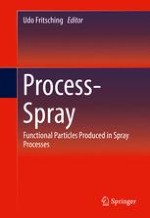2016 | OriginalPaper | Buchkapitel
16. Superheated Atomization
verfasst von : Astrid Günther, Karl-Ernst Wirth
Erschienen in: Process-Spray
Aktivieren Sie unsere intelligente Suche, um passende Fachinhalte oder Patente zu finden.
Wählen Sie Textabschnitte aus um mit Künstlicher Intelligenz passenden Patente zu finden. powered by
Markieren Sie Textabschnitte, um KI-gestützt weitere passende Inhalte zu finden. powered by
